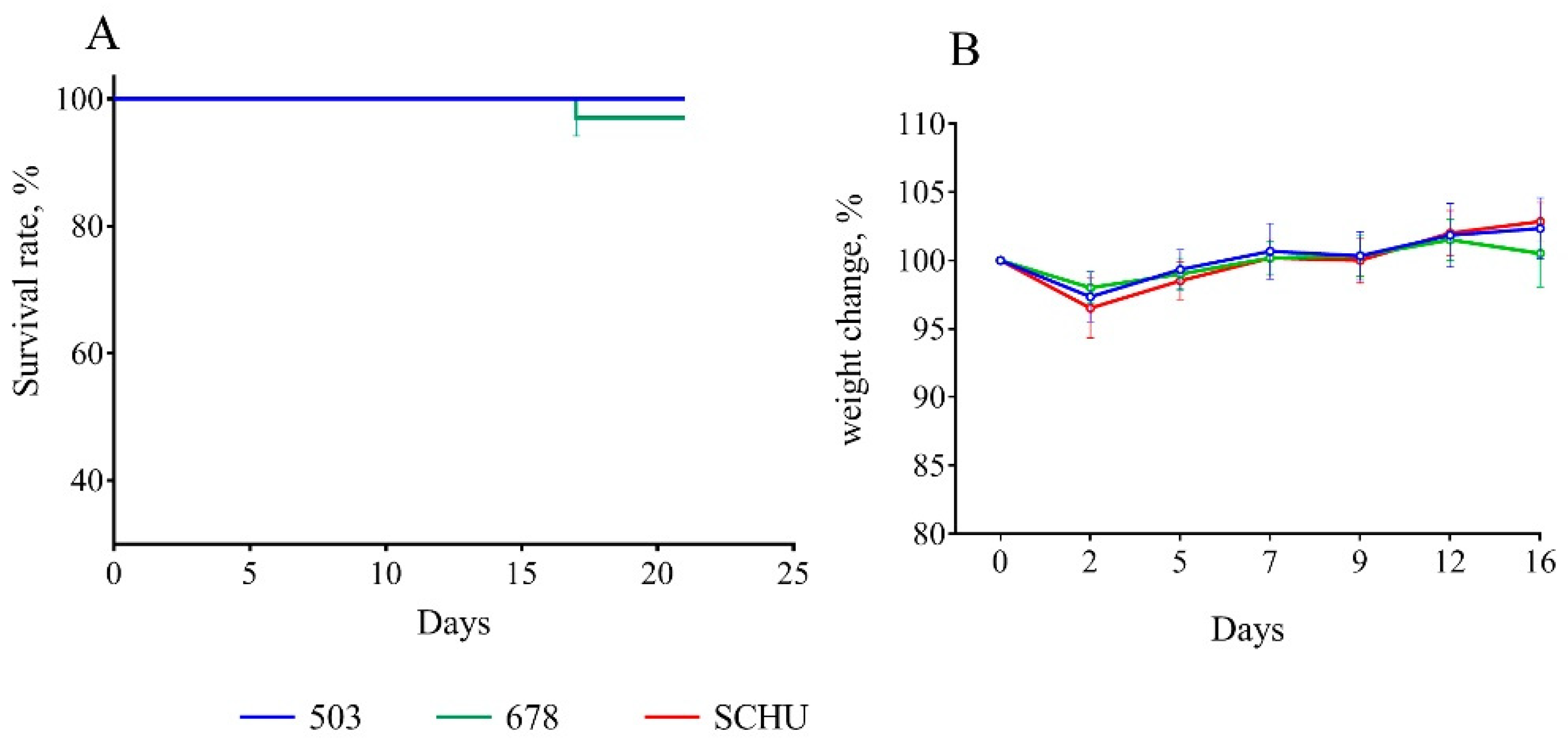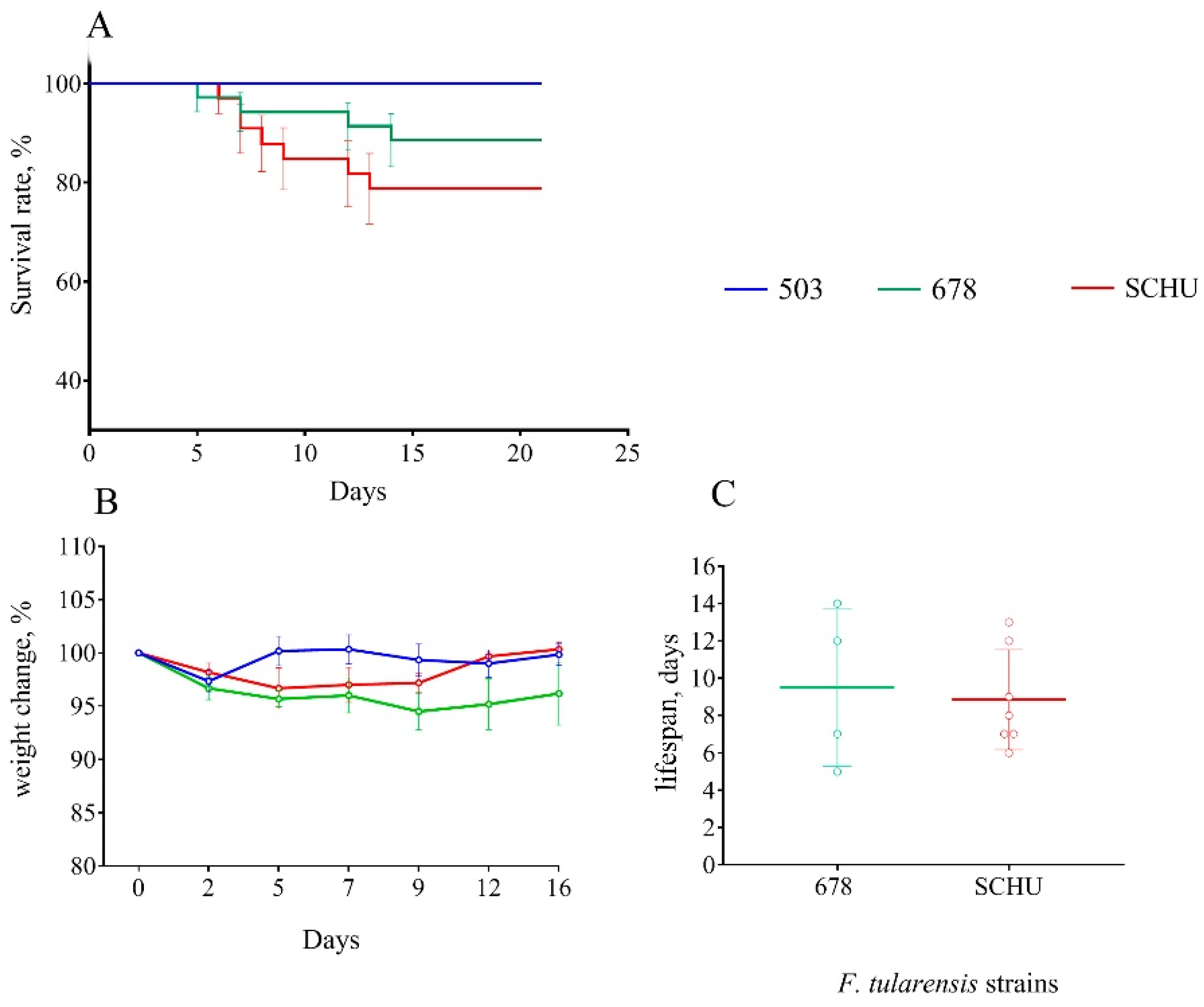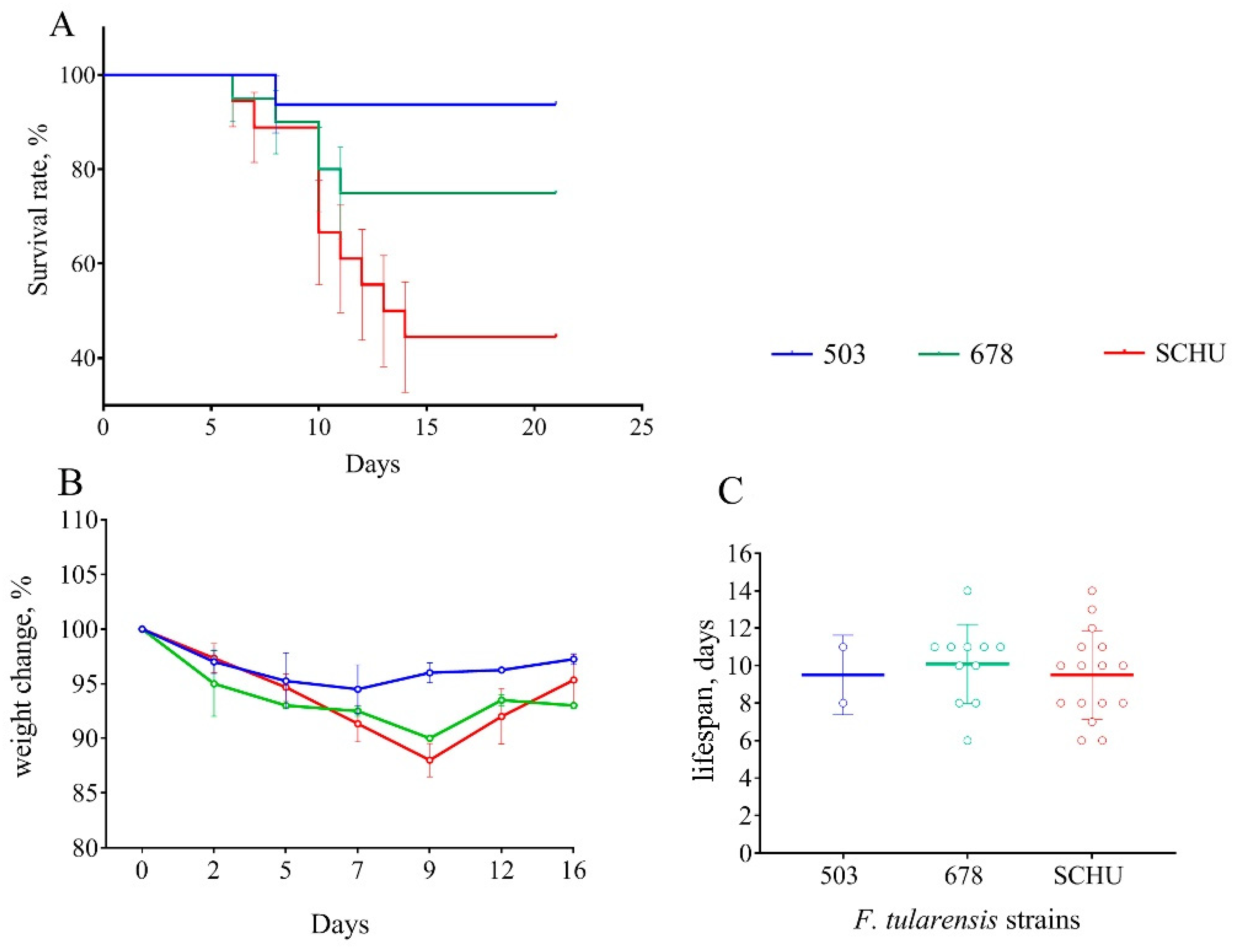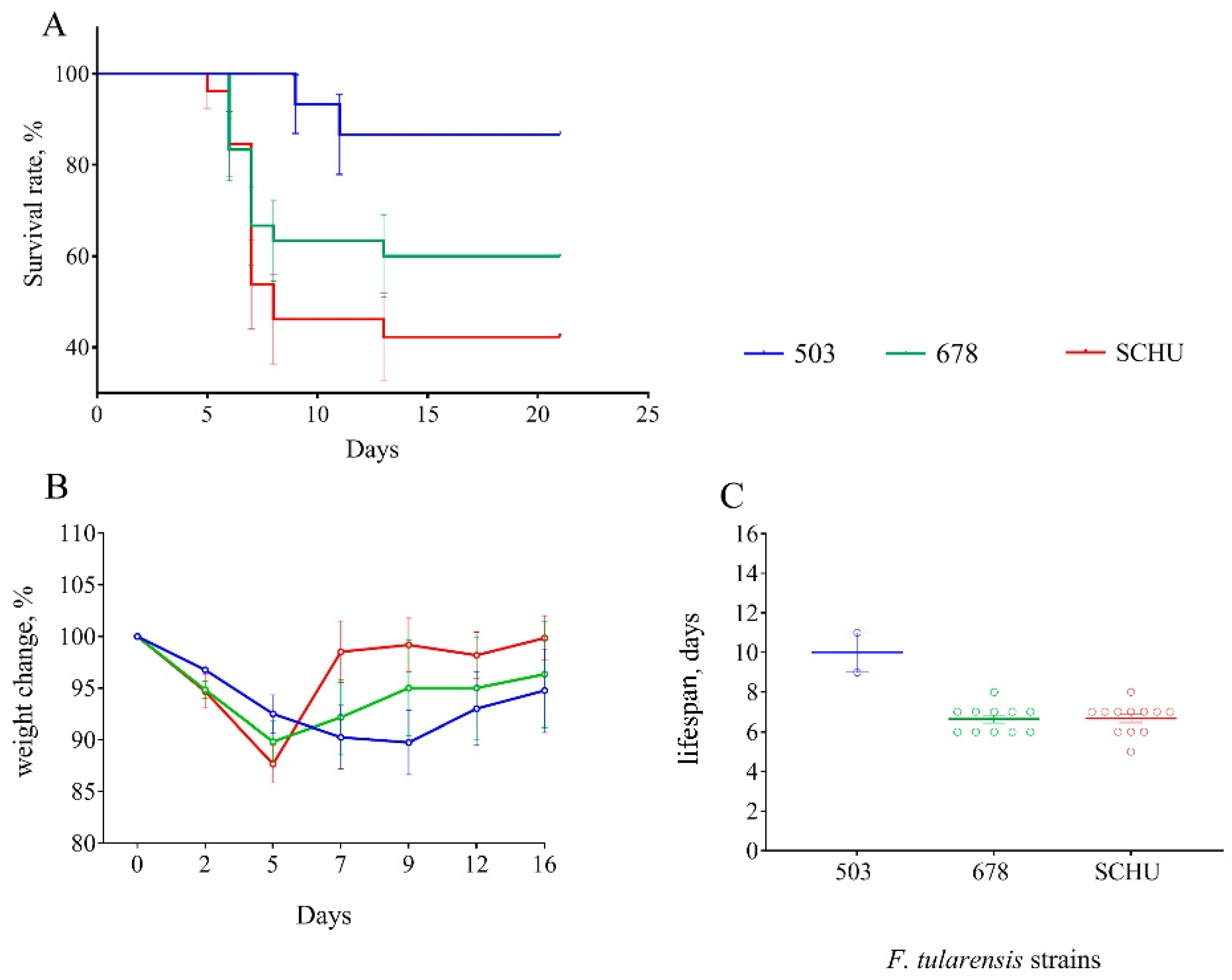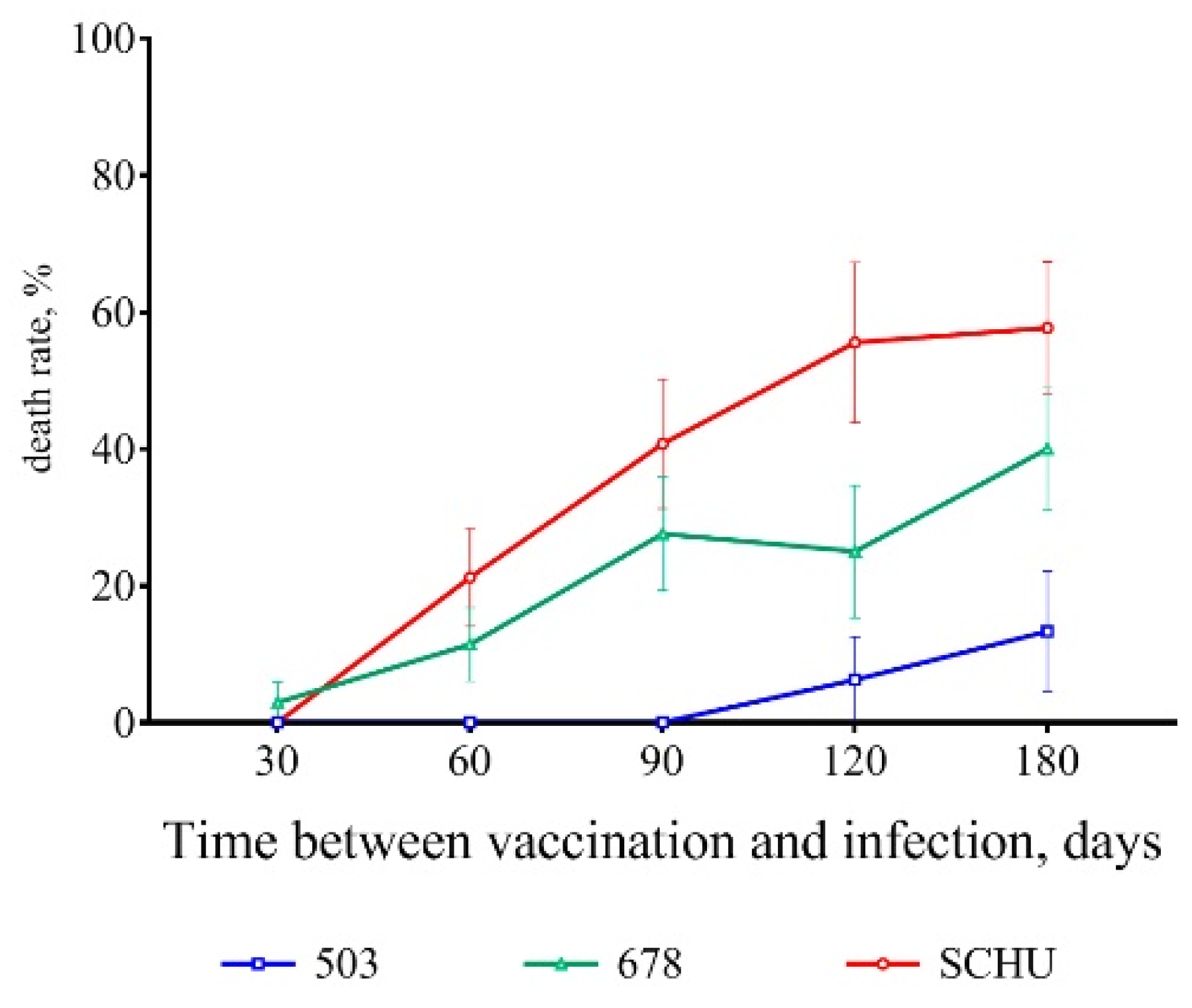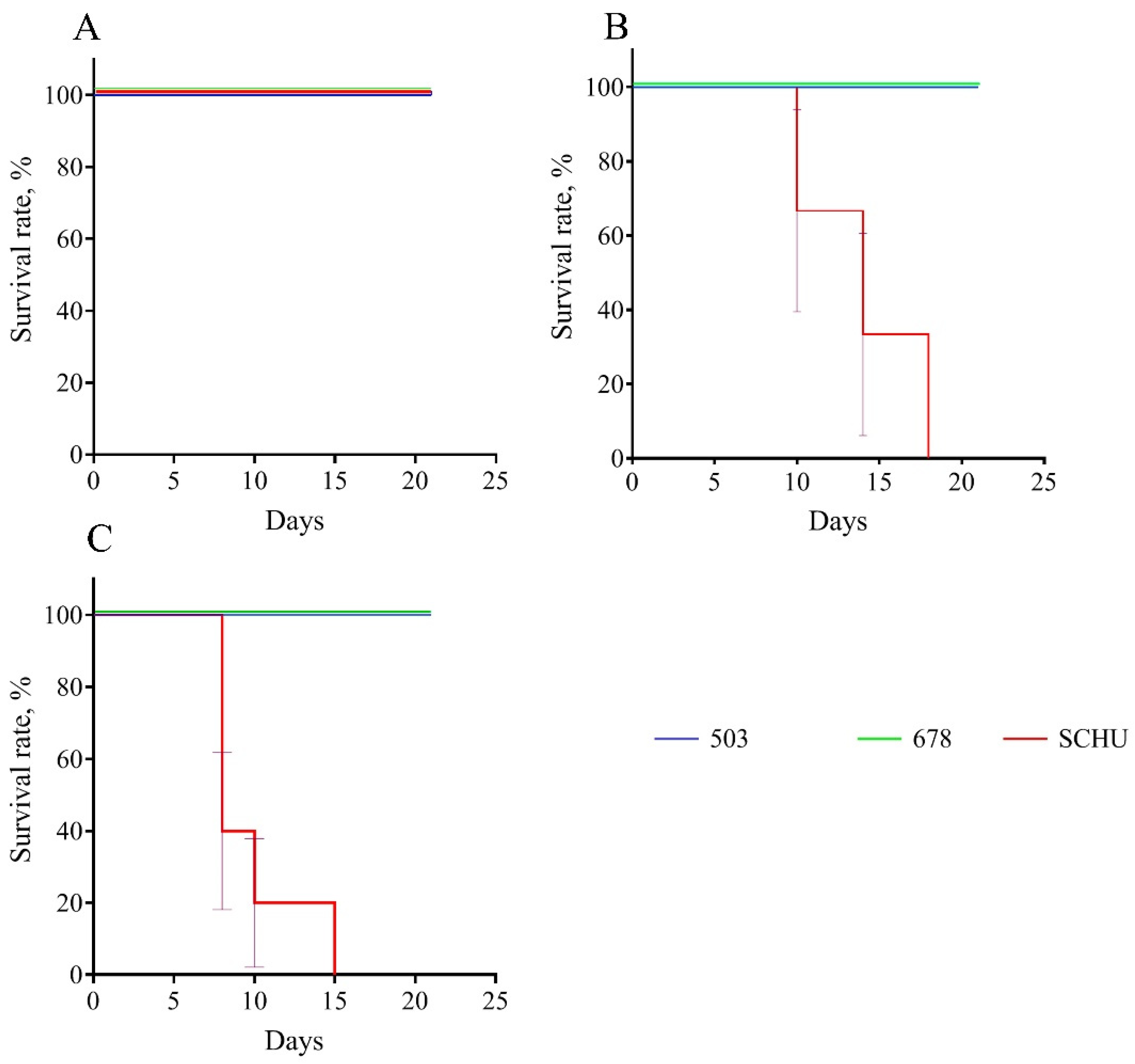1. Introduction
Francisella tularensis, a non-spore forming, encapsulated Gram-negative coccobacillus, is the etiologic agent of the potentially fatal zoonotic disease, tularemia. Currently,
F.
tularensis is divided into four subspecies:
tularensis (
nearctica),
holarctica (
palaearctica),
mediasiatica, and
novicida, which differ in their distribution and virulence in humans. While subsp.
tularensis (mainly found in North America) and subsp.
holarctica (widespread in the Northern hemisphere) are highly virulent for humans and can cause death among patients who do not receive timely and adequate treatment [
1,
2,
3,
4,
5], subsp.
novicida (present in North America, but some strains were isolated in tropical Australia and Southeast Asia (clinical isolates only)) is almost avirulent in humans, with only a few reports on its isolation in patients [
6,
7].
The fourth subspecies, subsp.
mediasiatica, remains the least studied. For a long time, this subspecies was thought to be found only in some regions of Kazakhstan and Turkmenistan in Central Asia. This geographic location is responsible for the subspecies name (in Russian, “Middle Asia” is a synonym for “Central Asia”). Previously, very little was known about the virulence of this subspecies, with no registered cases of subsp.
mediasiatica-caused tularemia among humans, although some data for animals show that its virulence in hares is similar to the virulence of subsp.
holarctica [
1]. In general, this subspecies has remained outside the area of interest of most researchers, due to its low prevalence. However, in 2013, we found subsp.
mediasiatica strains in the Altai region of Russia [
8]. We showed that the Altaic population of
F.
tularensis subsp.
mediasiatica is genetically distinct from the classical Central Asian population and is likely endemic to Southern Siberia.
Although no cases of human subsp.
mediasiatica causing infection have been detected in the Altai, the detection of this strain raised not only the theoretical question of the virulence of this subspecies but also an applied question: Are current antiepidemic measures (primarily vaccination) effective against this subspecies? For vaccination against tularemia, live vaccine strains are commonly used: LVS and 15 NIIEG (in Russia, NIIEG is the “Research Institute of Epidemiology and Hygiene”, now called the “Research Institute of Microbiology of Ministry of Defense of the Russian Federation”, where this vaccine was developed). Both these strains belong to the subsp.
holarctica. The effectiveness of live vaccines for infection prevention, including infections caused by strains of the most dangerous subspecies,
tularensis, has long been a focus of researchers. A number of publications have investigated how effectively existing vaccines can avoid infection in various ways [
9]. At the same time, the issue of overcoming post-vaccination immunity by strains of the subsp.
mediasiatica has not been studied at all. This is logical since such strains are practically absent in the collections of microorganisms. However, there are already a few dozen such strains in the SRCAMB collection (the state collection of pathogenic microorganisms and cell cultures, Obolensk, Russia), and every year, several new strains are found in Altai. Therefore, we have both the reason and the opportunity to investigate the comparative pathogenicity of subsp.
mediasiatica and its ability to cope with post-vaccinal immunity. Previously, we performed some preliminary experiments [
10] showing that mice vaccinated with a live vaccine strain endured the infections caused by different subspecies in different ways. In this model, subsp.
mediasiatica was shown to be less pathogenic than subsp.
tularensis but more pathogenic than subsp.
holarctica. However, the question remains whether the effectiveness of vaccination decreases over time. In the present manuscript, we investigate the dynamics of the pathogenicity of different subspecies in vaccinated mice and guinea pigs over six months.
4. Discussion
The comparison of different non-attenuated strains of
F. tularensis (including those belonging to different subspecies) according to their virulence using the direct infection of small laboratory animals is complicated by the high virulence of this pathogen: The LD
50 value is only 10
0–10
1 CFU/animal [
11,
12]. This is also true for subsp.
mediasiatica [
8,
10]. As shown in
Table 1 (Materials and Methods section), the LD
50 values for the strains of this subspecies do not generally differ from those of strains of other subspecies. To obtain a statistically reliable result with this approach, a large number of animals is required, which is difficult to justify in terms of the cost of the work, as well as for bioethical reasons. We tried to overcome this difficulty by using previously vaccinated animals. After vaccination, the animals acquired immunity that protected them from infection only from low virulent strains, whereas highly virulent strains were able to overcome this protection [
11,
12]. This made it possible to differentiate strains by virulence using even a relatively small number of animals in the experiment. Additionally, the challenge of vaccinated animals allowed an assessment of the effectiveness of the vaccination, demonstrating to what extent it was able to protect against that particular infecting strain. As we already mentioned for subsp.
mediasiatica, this issue remains insufficiently studied and is, therefore, especially interesting. We already used vaccinated mice in our previous work [
10], for which this approach seemed reasonable and allowed the
F. tularensis subspecies to be arranged in decreasing order of virulence for mice in the following order: subsp.
tularensis–subsp. >
mediasiatica–subsp. >
holarctica. In that work, only one preliminary experiment was carried out with the infection of mice 3 weeks after vaccination. However, post-vaccination immunity can eventually decrease [
13,
14]. Therefore, it remains interesting to trace how the pathogenicity of different subspecies changes with an increase in the time interval between vaccination and infection. In addition, different species of macroorganisms can react differently to infection and differ in their immune responses to vaccination. To draw conclusions about the comparative pathogenicity of certain microorganisms, including different subspecies of
F. tularensis, it is highly desirable to use more than one species of laboratory animals [
15,
16,
17]. Thus, in our present work, we significantly increased the duration of the experiment to 180 days and used an additional biomodel of guinea pigs.
For vaccinated mice at the beginning of the experiment, infection with any subspecies was shown not to be practically dangerous. However, with an increase in the time from vaccination to infection, the immune defense gradually became ineffective, and the mortality rate increased accordingly (
Table 2 and
Figure 1,
Figure 2,
Figure 3,
Figure 4,
Figure 5,
Figure 6 and
Figure 7). This decrease in effectiveness was directly proportional to time and depended on the subspecies. For subsp.
mediasiatica and subsp.
tularensis, the immune defense was overcome starting from 60 days. However, for subsp.
holarctica, even at 180 days after vaccination, most of the mice survived.
The same trends were observed for bodyweight loss during illness: (1) Weight loss increased with an increase in the time between vaccination and infection; (2) mice infected with subsp. mediasiatica and subsp. tularensis strains lost more weight than the mice infected with subsp. holarctica strain, with the exception of groups infected on the 180th day after vaccination, which lost approximately the same weight, regardless of the infecting strain.
We should note the mice that died from infection during the experiments seemed to lose bodyweight faster and more significantly than those that recovered. Therefore, every death led to an increase in the average body weight in the group. Thus, weighing the mice in groups was an integral indicator that averaged the responses to the disease among the two different subgroups–dead and recovered. It would be better to carry out individual weighing, which would possibly be more informative, despite requiring much more labor. Secondly, the weight loss caused by infection and subsequent weight gain during recovery is a process with complex dynamics over time. For example, it is difficult to determine what represents an indicator of a more severe disease–a significant decrease in body weight and rapid recovery or a less significant weight loss that persists for a longer time? Therefore, to compare the strains by pathogenicity, we used only one indicator of body weight, which is the most illustrative and easily detectable in our opinion–the maximum value (as a percentage of the initial body weight on the day of infection) at which the average body weight of a mouse in a particular group decreased during the observation period.
In addition to the mortality rate and body weight dynamics, we sought to identify differences in the severity of infection caused by different strains using a measurement of the life expectancy of the mice that died from this infection. Contrary to our expectations, the lifespan did not differ regardless of the infecting strain and the time interval between vaccination and infection. There was only one exception: At 180 days, the mice who died of a strain 503 infection had lived significantly longer than the mice who died of strains SCHU and 678 (again, there was no significant difference in this indicator between these two strains). However, in the experiment with six additional strains the life expectancy during infection caused by subsp. holarctica strains was slightly less than that of the other two subspecies. Thus, the life expectancy during infection was shown to be an inconvenient and insufficient visual indicator of pathogenicity and cannot be used to compare the pathogenicity of different strains.
Nevertheless, both the mortality rate and bodyweight loss caused by infection indicate that subsp. holarctica strains had low pathogenicity for vaccinated mice, but the subsp. mediasiatica and subsp. tularensis strains were highly pathogenic. Here, a statistically significant difference between the subspecies mediaasiatica and tularensis appeared only for the strain ACole, which was shown to be the most pathogenic of the strains used in this work. However, when we averaged the results for all strains of one subspecies, the differences between subsp. mediasiatica and subsp. tularensis became statistically insignificant. Summarizing the results obtained using the vaccinated mouse model, we can conclude that subsp. mediasiatica is noticeably more pathogenic than subsp. holarctica and is comparable in pathogenicity to subsp. tularensis. Like subsp. tularensis, subsp. mediasiatica was able to overcome post-vaccinal immunity starting from 60 days after vaccination with a live vaccine strain. The reasons for this reduced ability of the vaccination to protect mice against infection with subsp. mediasiatica remain controversial. Two reasons for this phenomenon can be assumed: (1) the greater virulence of this subspecies provided by the greater specificity of its pathogenicity factors for molecular targets in the mouse organism and (2) the differences in the antigenic composition of different subspecies. In this case, the antibodies produced during vaccination with strain 15NIIEG belonging to subsp. holarctica did not effectively bind to the antigens of the strains of the two other subspecies, thus yielding a poorer degree of infection prevention.
It would be interesting to assess this result in mice vaccinated with attenuated strains belonging to subsp. tularensis and subsp. mediasiatica by subsequently infecting them with virulent strains of different subspecies. Vaccination with subsp. mediasiatica strains may be more effective in protecting against infection with virulent strains of both the same subspecies and subsp. tularensis (considering their similarity in pathogenicity demonstrated in the present work). However, at the moment, there is no attenuated subsp. mediasiatica strain that retains the ability to persist in animals for a long enough time for the formation of an immune response.
In the guinea pig model, we obtained very different results. The vaccinated guinea pigs were fully protected from infection with strains 503 and 678 throughout the entire period of the experiment (i.e., for 180 days, no single death was recorded) but not from the SCHU strain: all animals infected with this strain 90 days after vaccination (and latter) died.
Thus, vaccination reliably protected guinea pigs from infection caused by the subsp. mediasiatica strain, as well as infection with the subsp. holarctica strain.
However, we detected some differences between strains 503 and 678. During the autopsy of the guinea pigs, we observed that the animals that died from infection with the SСHU strain (90 or more days between vaccination and infection) had multiple lesions of the liver, spleen, and lymph nodes. Even the surviving animals infected with this strain (30 days between vaccination and infection) had enlarged inguinal lymph nodes (closest to the site of infection) and noticeable pathological changes in the spleen (spleens were enlarged and had multiple small abscesses). At the same time, the guinea pigs infected with strain 503 did not have such pathologies, regardless of the time elapsed between vaccination and infection. However, even though they all survived, the animals infected with strain 678 experienced some pathogenic changes. All of them had enlarged inguinal lymph nodes, and one guinea pig even had a necrotic lesion of this lymph node. Moreover, they all had enlarged spleens with small multiple abscesses, as in the animals infected with the SСHU strain at 30 days after vaccination. Thus, there is reason to believe that strain 678 causes a slightly more severe infection than strain 503, although this infection is neither fatal nor accompanied by greater weight loss during illness. However even taking these differences into account, for the vaccinated guinea pigs, subsp. mediasiatica was comparable in pathogenicity to subsp. holarctica but not to subsp. tularensis and was not able to overcome post-vaccinal immunity.
Thus, we have shown that subsp.
mediasiatica is comparable in pathogenicity in mice with subsp.
tularensis and in guinea pigs with subsp.
holarctica. We also found that the live vaccine did not fully protect mice from subsp.
mediasiatica but completely protected guinea pigs for at least six months. To date, there has been little information in the literature on the virulence and pathogenicity of subsp.
mediasiatica. Articles that mention this subspecies (e.g., [
18]) only reported it to be less virulent for animals than subsp.
tularensis based on the primary source of this information (the works of Soviet scientists published in the 1960s–1970s). However, even in the original sources that we could find, information on the pathogenicity of subsp.
mediasiatica was not detailed enough. For example, the authors in [
19] only noted that “subsp.
mediasiatica is slightly more virulent for domestic rabbits than subsp.
holarctica”, without a detailed description of the experiments.
We originally studied the pathogenicity of subsp. mediasiatica for two biological models at once. However, we are aware that there is no reason to extrapolate our results to humans. It could be assumed that the virulence and pathogenicity of subsp. mediasiatica is even lower for humans than for guinea pigs, because subsp. mediasiatica strains have not caused a single known case of tularemia in humans. Moreover, since this subspecies was found in the Altai region of Russia in 2014, several of its strains have been isolated, but all of them were isolated only from ticks. There have been no clinical strains or strains isolated from captured wild rodents and/or from collected from corpses of rodents. Thus, our experimental data may not reflect the natural virulence of this subspecies in wild animals. However, these arguments remain speculative. Not a single purposeful expedition was conducted to collect subsp. mediasiatica strains to study the prevalence and natural virulence of this subspecies. All data were provided by the Altai anti-plague station, which cannot carry out such full-scale work. Thus, the lack of studies on field samples did not allow us to reconstruct the distribution of subsp. mediasiatica and its virulence among wild animals. Moreover, the absence of registered cases of tularemia caused by this subspecies in Russia may be due to insufficient diagnoses. In the mountainous Altai region, the infrastructure is poorly developed, and the population density is low, so the population is not sufficiently covered by medical supervision. Disease can occur in a secluded village, affect only isolated individuals, and/or circulate only in a mild form, thus not leading to the death or long-term disability of sick individuals. Such a case may remain outside the interest of doctors and not be registered. However even this probability suggests either a low prevalence of this microorganism in the Altai region or extremely insignificant clinical manifestations of the infection in humans sufficient to avoid the attention of doctors.
Nevertheless, we cannot completely exclude the hypothetical possibility of human tularemia caused by subsp. mediasiatica strains endemic to Russia. We must be prepared for such a possibility, and we must determine how to counteract it. Vaccination remains the primary way to avoid tularemia infection. In this way, the previously unexplored ability of existing antitularemia vaccines to prevent infection with subsp. mediasiatica has acquired new relevance. Although the results of our experiments were significantly different between the two different biomodels, in general, subsp. mediasiatica did not show an unexpectedly high ability to overcome post-vaccination immunity. However, this subspecies is pathogenic for vaccinated laboratory animals and is capable of causing a fatal infection or at least some pathological changes. This fact should be taken into account when developing new anti-tularemia vaccines. To assess the ability of such vaccines to prevent tularemia infection, it would be interesting to challenge vaccinated experimental animals with not only subsp. holarctica and subsp. tularensis strains, but also with subsp. mediasiatica strains.
Although subsp. mediasiatica has similar pathogenic properties to subsp. tularensis for mice and subsp. holarctica for guinea pigs, we can still say that, overall, subsp. mediasiatica assumes an intermediate position between the other two subspecies. Its similarity in virulence for mice with subsp. tularensis is most interesting from the perspective of the evolutionary relationship between F. tularensis subspecies, not from the perspective of epidemiology.
